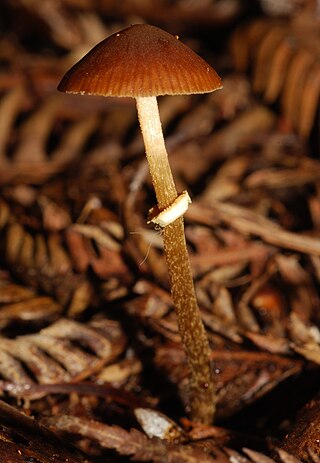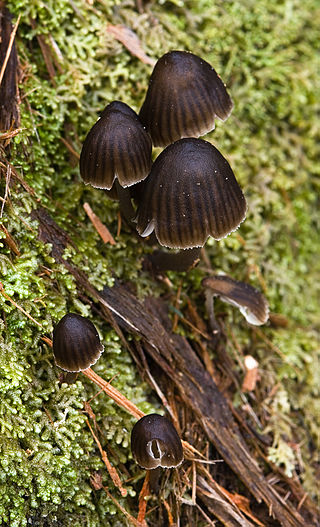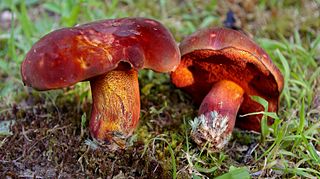
Conocybe is a genus of mushrooms with Conocybe tenera as the type species and at least 243 other species. There are at least 50 different species in North America.

Conocybe rugosa is a common species of mushroom that is widely distributed and especially common in the Pacific Northwest of the United States. It grows in woodchips, flowerbeds and compost. It has been found in Europe, Asia and North America. It contains the same mycotoxins as the death cap mushroom. Conocybe rugosa was originally described in the genus Pholiotina, and its morphology and a 2013 molecular phylogenetics study supported its continued classification there.

Pholiotina cyanopus is a species of fungus that contains psychoactive compounds including psilocybin and the uncommon aeruginascin. Originally described as Galerula cyanopus by American mycologist George Francis Atkinson in 1918. It was transferred to Conocybe by Robert Kühner in 1935 before being transferred to Pholiotina by Rolf Singer in 1950. A 2013 molecular phylogenetics study found it to belong to a group of species currently assigned to Pholiotina that are more closely related to Galerella nigeriensis than to Pholiotina or Conocybe. It is likely that it will be moved to a different genus in the future, but this has not happened yet.

The Bolbitiaceae are a family of mushroom-forming basidiomycete fungi. A 2008 estimate placed 17 genera and 287 species in the family. Bolbitiaceae was circumscribed by mycologist Rolf Singer in 1948.

Mycena nargan, commonly known as the Nargan's bonnet, is a species of fungus in the family Mycenaceae, and the sole member of the section Nargan in the genus Mycena. Reported as a new species in 1995, it is known predominantly from Southern Australia. The saprobic fungus produces mushrooms that grow on well-decayed wood, often on the underside of wood lying in litter. The dark chestnut-coloured caps are covered with white, easily removed scales, and reach diameters of up to 2 cm (0.8 in) wide. The pale, slender stems are up to 5 cm (2.0 in) long and have white scales at the base. On the underside of the cap, the cream-coloured gills are widely spaced and bluntly attached to the stem. The edibility of the mushroom is unknown.

Psilocybe yungensis is a species of psychedelic mushroom in the family Hymenogastraceae. In North America, it is found in northeast, central and southeastern Mexico. In South America, it has been recorded from Bolivia, Colombia, and Ecuador. It is also known from the Caribbean island Martinique, and China. The mushroom grows in clusters or groups on rotting wood. The fruit bodies have conical to bell-shaped reddish- to orangish-brown caps that are up to 2.5 cm (1.0 in) in diameter, set atop slender stems 3 to 5 cm long. The mushrooms stain blue when bruised, indicative of the presence of the compound psilocybin. Psilocybe yungensis is used by Mazatec Indians in the Mexican State of Oaxaca for entheogenic purposes.

Boletus rubroflammeus is a species of bolete fungus in the family Boletaceae. First described from Michigan in 1971, it is found in the eastern United States and Mexico, where it grows in a mycorrhizal association with hardwood trees. The fruit bodies (mushrooms) of the fungus have caps that are deep red to purplish red, and dark red pores. The stem has coarse, dark red reticulations and a narrow yellow area at the top. All parts of the mushroom quickly stain blue when injured or cut. Lookalikes include Boletus flammans, a lighter-colored species that grows with conifers. Other similar species can be distinguished by differences in distribution, morphology, staining reaction, and microscopic characteristics. Boletus rubroflammeus mushrooms are poisonous, and can cause gastrointestinal distress if consumed.
Leucocoprinus minutulus is a species of mushroom producing fungus in the family Agaricaceae.

Conocybe macrospora is a species of mushroom-producing fungus in the family Bolbitiaceae.
Conocybe anthuriae is a species of mushroom-producing fungus in the family Bolbitiaceae.
Conocybe volvata is a species of mushroom-producing fungus in the family Bolbitiaceae.
Conocybe volviradicata is a species of mushroom-producing fungus in the family Bolbitiaceae.
Conocybe corneri is a species of mushroom-producing fungus in the family Bolbitiaceae.
Conocybe vaginata is a species of mushroom-producing fungus in the family Bolbitiaceae.
Conocybe volviornata is a species of mushroom-producing fungus in the family Bolbitiaceae.
Conocybe crispella is a species of mushroom-producing fungus in the family Bolbitiaceae.

Conocybe mesospora is a species of mushroom-producing fungus in the family Bolbitiaceae.
Conocybe subxerophytica is a species of mushroom-producing fungus in the family Bolbitiaceae.
Conocybe affinis is a species of mushroom-producing fungus in the family Bolbitiaceae.
Conocybe subpallida is a species of mushroom-producing fungus in the family Bolbitiaceae.









